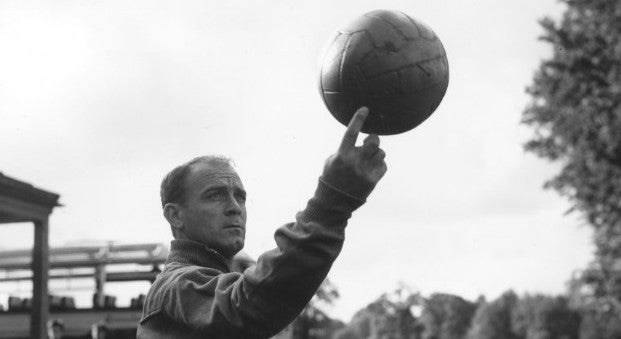
Alfredo Di stefano
Alfredo Di stefano
There’s always a bit of drama when it comes to the world’s most beloved sport and its players. Particularly when it comes to clubs acquiring players. In the case of De Stefano, born in Buenos Aires in 1926 and regarded as one of the world’s best players of all time, there was more than just a bit… With a nickname of “Saeta Rubia” (blonde arrow), he was truly a TENLEGEND - powerful, quick, with vision and creativity, stamina and grace. 
REAL MADRID
We know Di Stéfano as the Real Madrid legend who led Los Blancos to numerous European glories. He began his career as a 17 year-old forward for River Plate, scoring hundreds of goals in Argentina before moving to Millonarios in Colombia. Naturally, Di Stéfano caught the eye of the two biggest and wealthiest clubs in the world, and they both intended to acquire him. One came away victorious, and the other would come away empty handed.
A few years before Barcelona or Real Madrid approached the player, Di Stéfano left River Plate for Millonarios, around the time of the famed strike. This is significant, as the strike would cast confusion about which club actually owned Di Stéfano’s player registration rights.
After their initial offer to Millonarios fell through, Barcelona ignored the Colombian club for all future negotiations, believing that River Plate owned the legal rights to Di Stéfano’s player registration. Barcelona agreed to River Plate’s terms and got Di Stéfano on a plane to Catalonia thinking they had the world’s most renowned player at the time.

Madrid smelled an opportunity, and pounced. Real reached an agreement for Di Stéfano as well, although not with River Plate, but with Millonarios. This is the club Di Stéfano was playing for at the time, but the question was whether his transfer there had been legal from the start.
In the end, Barcelona had an agreement with River Plate, who held Di Stéfano’s never-voided player registration from before he went on strike. Real Madrid had an agreement with Millonarios, who held Di Stéfano’s current player registration. With both clubs claiming legitimate ownership of the player, things got confusing quickly, to the point where the world’s governing football organization had to step in to settle the argument.

FIFA decided that both Barcelona and Real Madrid had signed Di Stéfano and that they had to share the forward for each of the next four seasons, with him spending two full campaigns with each club. This chain of events essentially forced Barcelona president Marti Carreto to resign. Barcelona's interim board following Carreto’s resignation rejected FIFA’s offer to share Di Stéfano. After a first few unimpressive games with Di Stefano, they threw away the agreed contract with the player.
The Argentine was now officially free to legally join Madrid. In the end, Real paid 5.5 million Spanish pesetas for the transfer, plus a 1.3 million bonus for the purchase, an annual fee to be paid to the Millonarios, and a 16,000 salary for Di Stéfano with a bonus double that of his teammates, for a total of 40% of the annual revenue of the Madrid club at the time. This fact contributed greatly to intensifying the rivalry with the Catalan club. While there’s no proof Di Stéfano’s move to Barcelona was sabotaged, there are many who believe, to this day, that politics again meddled in sporting affairs.
In 1953 Di Stéfano arrived at Real Madrid. Di Stéfano scored a brace in his first El Clásico, a 5-0 destruction. With Di Stéfano leading the lines, where he partnered with several outstanding forwards, including Puskas, Raymond Kopa, and Gento, Real Madrid went on to claim five European Cups.

During his 11 seasons in Madrid, Di Stéfano led the league in scoring in four straight seasons (1956–59) and helped the team to win eight first-division titles (1954–55, 1957–58, 1961–64), the Spanish Cup (1962), five European Cups (1956–60), and the inaugural Intercontinental Cup (1960) played annually between the European and South American champions.
He is regarded as one of the greatest centre forwards in football history… a LEGEND! Join us.
Be a TENLEGEND.TM
